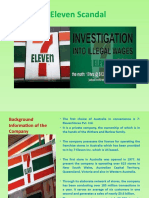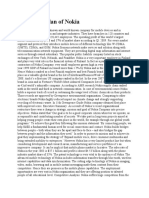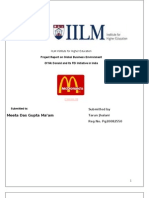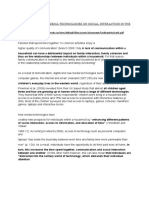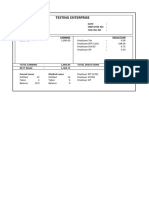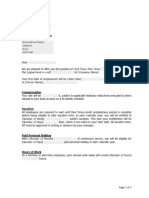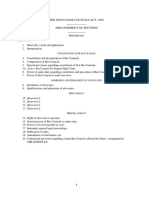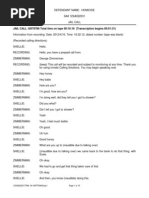0 ratings0% found this document useful (0 votes)
109 viewsBA 175 Overall Paper Final
BA 175 Overall Paper Final
Uploaded by
Ged Payno- The document discusses Kamiseta's plan to expand its women's fashion brand from the Philippines to Malaysia.
- Malaysia presents opportunities for growth due to similarities to the Philippines in climate and body types. However, cultural differences exist particularly regarding modest dress standards influenced by Islam.
- Kamiseta will use a franchising strategy and adjust products to be more conservative while keeping prices competitive with local and international brands. Limited "skimpy" styles will be offered and shawls added to lines.
Copyright:
© All Rights Reserved
Available Formats
Download as PDF, TXT or read online from Scribd
BA 175 Overall Paper Final
BA 175 Overall Paper Final
Uploaded by
Ged Payno0 ratings0% found this document useful (0 votes)
109 views9 pages- The document discusses Kamiseta's plan to expand its women's fashion brand from the Philippines to Malaysia.
- Malaysia presents opportunities for growth due to similarities to the Philippines in climate and body types. However, cultural differences exist particularly regarding modest dress standards influenced by Islam.
- Kamiseta will use a franchising strategy and adjust products to be more conservative while keeping prices competitive with local and international brands. Limited "skimpy" styles will be offered and shawls added to lines.
Original Description:
BA 175, Global marketing, Market Research, co-maker, group work, UP diliman, vsb
Copyright
© © All Rights Reserved
Available Formats
PDF, TXT or read online from Scribd
Share this document
Did you find this document useful?
Is this content inappropriate?
- The document discusses Kamiseta's plan to expand its women's fashion brand from the Philippines to Malaysia.
- Malaysia presents opportunities for growth due to similarities to the Philippines in climate and body types. However, cultural differences exist particularly regarding modest dress standards influenced by Islam.
- Kamiseta will use a franchising strategy and adjust products to be more conservative while keeping prices competitive with local and international brands. Limited "skimpy" styles will be offered and shawls added to lines.
Copyright:
© All Rights Reserved
Available Formats
Download as PDF, TXT or read online from Scribd
Download as pdf or txt
0 ratings0% found this document useful (0 votes)
109 views9 pagesBA 175 Overall Paper Final
BA 175 Overall Paper Final
Uploaded by
Ged Payno- The document discusses Kamiseta's plan to expand its women's fashion brand from the Philippines to Malaysia.
- Malaysia presents opportunities for growth due to similarities to the Philippines in climate and body types. However, cultural differences exist particularly regarding modest dress standards influenced by Islam.
- Kamiseta will use a franchising strategy and adjust products to be more conservative while keeping prices competitive with local and international brands. Limited "skimpy" styles will be offered and shawls added to lines.
Copyright:
© All Rights Reserved
Available Formats
Download as PDF, TXT or read online from Scribd
Download as pdf or txt
You are on page 1of 9
OVERALL GLOBAL MARKETING STRATEGY: MALAYSIA
Aguinalde. Custodio. Payno. Santos & Versoza
BA 175 : Global Marketing | Prof. Tubianosa
1
I. Introduction
Kamiseta is a Philippine fashion brand that is owned by Shoppes Manila Inc., of which established its first
boutique in the year 1962, over the course of its success in the Philippine fashion industry it has grown to
over 60 branches in the Philippines and have established its presence in Indonesia through its 7
branches.
The Target Market
The Kamiseta brand is targeted to women, ages 16-34. Its merchandise caters to different usage needs
of the consumers but each item never fails to give out that casual, classic, laidback feel for the consumer.
Kamiseta products are for the young and feeling young.
Its Positioning
Affordable, Friendly Customer Service and most of all, Quality clothing with the Triple C personality;
: Its fun being a girl Its Current Brand Tagline
: Katie Holmes Its Current Brand Ambassador
The Landscape of Opportunity
Based on our findings, Malaysia has a similar climate like that of the Philippines this is very important
because this fits with the Kamisetas brand proposition on its clothing line namely the Triple Cs which
stands for Cool, Casual Classics). An additional finding which widens the window of opportunity is that
Malaysians have similar body features/structures with Filipinos, this enables Kamiseta -with ease- cater
its current product line.
The opportunity to expand to Malaysia is backed up by several environmental factors such as the
countrys minimal resistance in political and economic aspect, as for the social aspect, it is the openness
of the Malaysians to a wide ranges of fashion styles, the decreasing young Malaysian population and
the increase in the countrys tourism.
Yet, it is the market potential and the economic environment of Malaysia which makes the country
attractive. With the country being an emerging middle-income economy this perfectly fits the overall
affordable pricing strategy of Kamiseta, backed-up by a Market Potential of 12.5 (based on Balance
Score Card). This ultimately justifies the potential and the need to establish a foothold by Kamiseta in
Malaysias thriving fashion industry.
II. Foreign Entry Strategy
Franchising
Kamiseta will incur lesser cost if they will choose to export products to Malaysia. Malaysia have the lowest
shipment cost complemented by a fast and in-time delivery of imported goods. Moreover, with the efforts
of the government to induce a more liberal trade with neighboring countries, they reduced their tariffs to
attract trade and investments in Malaysia. On the other hand, if Kamiseta would manufacture in Malaysia,
they would incur a higher cost in production. Malaysia has high labor cost and raw materials. Cotton,
OVERALL GLOBAL MARKETING STRATEGY: MALAYSIA
Aguinalde. Custodio. Payno. Santos & Versoza
BA 175 : Global Marketing | Prof. Tubianosa
2
which is the primary material for Kamiseta, is currently increasing, which is has been alarming for clothing
manufacturers.
Decision Criteria for International Business
1. Political Risk
Due to the continuity of policies in the Malaysian Government, Kamiseta will be able to have less costly
operation due to the stability of policies. Plans will be more effective due to the lack of urgency to provide
modification to planned strategies thus being able to run as smoothly as possible. The economic growth
for Malaysia will be stable for a couple of years; with the long-term plans and effective government,
implementing economic plans for Malaysia will be accomplished, thus, a stronger economy and a lower
political risk for Kamiseta.
2. Market Access
The lengthy property registration in Malaysia makes it more difficult for Kamiseta to register their assets
especially if they would like to construct their own manufacturing plant. There are also numerous licenses
and approvals required to carry out business. Obtaining a license is longer compared to the average of
other countries. Lastly, they are also poor in enforcing contracts. These scenarios in the market access
would hamper Kamiseta in securing licenses and contracts if they would put a manufacturing plant in
Malaysia since putting up a manufacturing plant would require more contracts and licenses to be
processed.
3. Factor Costs and Conditions
Investors can easily get credit in Malaysia if they need additional capital for their investments. This is
Malaysias strategy to attract more foreign investors in their country. Even though Kamiseta could easily
get additional funding, Malaysia has a relatively high labor costs. If ever Kamiseta would construct a
manufacturing plant in Malaysia, they will incur high labor costs for their tailors.
4. Shipping Considerations
Costs in exporting goods to Malaysia are relatively lower to other Asian countries. Tariffs has been
reduced in order for them to have a more open and liberal economy. In addition, they have the lowest
cost to import goods with only $450 per container. Also, they a relatively faster time to import goods.
These indications invites Kamiseta for a exporting their goods to Malaysia.
5. Country Infrastructure
A sufficiently developed infrastructure would entail smoother operations for Kamiseta; sufficient
infrastructure in Malaysia would in turn contribute to the reduction of business costs of Kamiseta; less
operational nuisances in day to day business activities brought about by (e.g. power outages) will
increase productivity of its people and stores.
6. Foreign Exchange
The efforts for a stable economy results to a stable prices for commodities that are going to be used by
Kamiseta if ever it would enter Malaysia with its production. Since the Malaysian Ringgit is improving, it
can be derived that the economy of Malaysia is getting stronger. A stronger economy could affect the
prices of the commodities in Malaysia, resulting to cheaper materials for raw and construction materials
upon entering the market.
In order to further analyze Kamisetas market entry strategy, we can use a matrix that differentiates
between difficulty to enter a market and cultural distance. The group identified that Malaysia is culturally
distant between Malaysia mainly because of the difference with religion- Islam. Majority of Malays
practice Islam which greatly affects the way they dress. In government offices and temples, short and
sexy clothing are prohibited. The dress code implemented is anchored from Islamic belief of aurat,
which obligates to cover body parts that should not be exposed.
OVERALL GLOBAL MARKETING STRATEGY: MALAYSIA
Aguinalde. Custodio. Payno. Santos & Versoza
BA 175 : Global Marketing | Prof. Tubianosa
3
It is relatively easy to enter the Malaysian clothing industry. As we have found out in our decision criteria,
import cost to Malaysia is one of the lowest in Asia. Furthermore, required documents to import and
delivery time is comparatively fast against other Asian countries. To supplement the low costs for trade,
the Malaysian government reduced tariffs to obtain a more open and liberal economy. On the other
hand, switching costs is high because of numerous brands in the industry. However, Kamiseta
differentiates from competition by targeting a specific segment, offering a unique type of clothing and
strategic pricing.
III. STP
Kamiseta should retain its STP in their expansion to Malaysia because it is the equity of the brand.
IV. The 4 Ps
Product - make skimpy pieces a limited line, retain design/prints and maintain organized
merchandise and attractive store layout
With Malaysias conservative culture, largely affected by the Muslim religion, product adjustments are
necessary. Bottoms with hems that fall above the knee (short skirts or shorts) will be limited as demand
for these would be low. Shawls will also be added to the product line.
We know that Kamiseta has the strength when it comes to pulling its consumers through its attractive and
consistent product merchandising and store layout. Kamiseta stores are organized, easy to navigate,
friendly, cozy and hip and pretty much how its target markets closet wants to look like. From the
interviews, we have inferred that the target market places high consideration to the product
merchandising and store layout. We feel the need to emphasize that the Kamiseta store layout and
product merchandising have the same and consistent feel anywhere in the world.
Price - Implement competitive pricing with both local and international brands.
The average fashion articles price are as follows:
Average clothing price per unit = RM 29.90
Average footwear price per unit = RM 42.90
Average apparel price per unit = RM 31.85
(Source: Apparel - Malaysia, Euromonitor International, June 2011)
The biggest players would still be international/global brands such as Adidas, Nike and Reebok, however
these are not direct competitors as far as the line of products are concerned.
Mango, Zara, Esprit and Giordano, whose clothing lines are more similar with Kamiseta, make them
closer competitors. Said brands have a price range from RM 39 (casual wear) to RM 559 (more dressy
pieces), while local players like Kiki Lala and Padini have a lower range of prices even, a little below the
average price of apparel. We would want to stay competitive with both international and local
brands. Additionally, we consider the knowledge and expertise of our potential franchisee in controlling
the prices of the merchandise. The brand would implement a geocentric pricing strategy where franchise
and headquarters will coordinate in coming up with optimal prices for the brand value. Upon entry,
Kamiseta will introduce its lines at a price range of RM 36 to RM 141, directly taken from Philippine prices
(Online Source: www.kamiseta.com/my-dressing-room.php#), keeping prices lower than foreign brands
but still competitive to create a perception of good quality among the market.
OVERALL GLOBAL MARKETING STRATEGY: MALAYSIA
Aguinalde. Custodio. Payno. Santos & Versoza
BA 175 : Global Marketing | Prof. Tubianosa
4
Place - Malls in Kuala Lumpur with good foot traffic and accessibility to Malaysian teens and
tourists.
From the interviews, we found out that girls prefer to shop in in retail stores rather than in department
store. As per sales by distribution format, store-based retailing and non-grocery retailing have the highest
sales percentages.
We would want that Kamiseta stores be present in the Bintang Walk or the shopping and entertainment
district in Kuala Lumpur. The Bintang Walk is popular among tourists and locals especially to the youth.
Along the Bintang Walk lie shopping malls targeting different ages, incomes and interests. The Berjaya
Times Square, Lot 10, Fahrenheit 88 and Sungwei Plaza are the following malls that have the highest
foot traffic from the target market, great accessibility for both locals and tourists and targeted towards
middle income consumers. We have evaluated that our brand, Kamiseta has a great fit with the following
locations and have a higher chance of succeeding in these places. (Online Source: Wikipedia and
http://www.kuala-lumpur.ws/klshopping/modern.htm)
Promotions - A Three-Phase Integrated Marketing Communications plan would be implemented.
With the research, and entry strategies covered, Kamiseta is now ready to let its presence be known to
Malaysia. This would be accomplished through AT FIRST SIGHT: The Kamiseta IMC Campaign for
Malaysia
The Campaign Title Rationale: At First Sight is a frame of mind that could be attributed to anything
that moves a person instantly, be it love, fun or comfort whichever makes a person respond upon
something they see. Whether its seeing the ads of Katie Holmes by the billboards or just looking at
fashion articles displayed the store window;
At First Sight talks to the consumer that they must take a closer look at the clothes of Kamiseta, examine
the details, to feel it, to wear it and let Kamiseta be a part of her.
What we see, make us think and when they do, sparks fly. With Kamisetas captivating, laid back, cool
casual classics brightened by its fun and elegant persona all of which radiates from not only its products,
but with the store, it ads and its people, girls are bound to be smitten at first sight.
The At First Sight Campaign for Kamiseta is a three-phase campaign which will commence in a span of
one year and will be sustainable for the upcoming years. The core objectives of the campaign are as
follows:
(1) Awareness Creation,
(2) Induce Trial and Build Likeability and
(3) Brand Loyalty Creation;
OVERALL GLOBAL MARKETING STRATEGY: MALAYSIA
Aguinalde. Custodio. Payno. Santos & Versoza
BA 175 : Global Marketing | Prof. Tubianosa
5
Phase 1: Getting to Know You
Objective - Create Awareness and Interest
Duration: 1-2 Months
Implementation of the 1st phase would be through the following Mediums:
1. Print Advertising - Fashion Magazines based in Kuala Lumpur and such as Cine Fashion Magazine,
Nur, and Jelita Magazine
2. Billboard Advertising - Will contain the same endorser/s (Katie Holmes) and feel, with the exception
of showing too much skin on the pegs/images found therein.
3. Product Launch - Store openings wherein Key Influencers and Local Celebrities will be invited so as
to gather more local media mileage for Kamiseta. This should create enough advertorials to let people
know Kamiseta is now in Malaysia.
Phase 2: Hanging Out
Objective - Induce trial and Build Brand Likeability
Duration: 1-2 Months
Implementation of the 2nd phase would be through the following Mediums:
1. Online Public Relation - Have online writers female fashion bloggers to write a review on the
Kamiseta stores, services and provide them sponsored product lines to try on.
2. Product Activation - A Photobooth will be set up where consumers can try on Kamiseta product
and get a picture with it and if they like it, they can immediately buy their tried outfit.
3. Kamiseta Best Photo Contest - Fun moments of being girl could happen anytime and anywhere
and with anybody youre with, with this contest aims to
4. Kamiseta Fashion Designing Contest - Kamisetas brand personality aside from the 3 Cs is
that it is friendly, approachable and really understands what being a girl/ woman is. This contest
aims for Kamiseta to interact more with its consumers and get insights on the designs or styles
that are unique to Malaysian women.
Phase 3 - Best Friends Forever
Objective - Create Brand Loyalty
Duration: 6 months onwards.
Implementation of the 2nd phase would be through the following Mediums:
1. Online Social Media - Create a feedback page (through Facebook or any other popular social
networking site) for the customers of Kamiseta in Kuala Lumpur, this will serve as a place for
them to share their experiences with the Kamisetas stores and clothes.
Furthermore, in order to optimize Kamisetas Online Social Media. A Facebook page will be
created to support an interactive activity with its customers. Kamiseta will post directions and
guidelines for customers to send their photos wearing Kamiseta clothes in a certain
place/occasion/event that highlights the fun moments in being a girl.
2. The Kamiseta Card - A rewards system which entitles loyal Kamiseta buyers to avail certain
privileges, By doing so this will make the customers a feeling of true ownership and sense of belonging to
Kamiseta. Such privileges will/would include:
Availing of Discounts
Special Offers
Priority/Exclusive Invite and Access to Kamiseta Events, such as Fashion Shows or Sneak Peeks
at Upcoming Product Lines
Kamiseta Complimentary Giveaways during Holiday Celebrations or Store Anniversaries.
OVERALL GLOBAL MARKETING STRATEGY: MALAYSIA
Aguinalde. Custodio. Payno. Santos & Versoza
BA 175 : Global Marketing | Prof. Tubianosa
6
V. Conclusion
Having seen the opportunity in Malaysia for Kamiseta, the strategies set from entry to the marketing
mix will capture the present opportunity and benefit the company by effectively presenting the brand to
the country and catering to its target market.
With all these programs, Team Kamiseta believes that At First Sight campaign will definitely achieve its
objectives over the course of one year. Through our campaign we will enable the target market to be truly
smitten with Kamiseta, At First Sight.
Overall Kamiseta is ready to set foot and make its mark in the Malaysian Fashion industry, to be truly a
global Filipino brand that will be loved and will continue to grow and branch out through Malaysia over the
coming years.
OVERALL GLOBAL MARKETING STRATEGY: MALAYSIA
Aguinalde. Custodio. Payno. Santos & Versoza
BA 175 : Global Marketing | Prof. Tubianosa
7
Appendix
Exhibit A: Foreign Market Entry Decision Criteria:
Political Risk - risk of a change in government policy that would adversely impact a companys ability to
operate effectively and profitably. Lower political risk means higher investments from outside companies.
Stable economy and economic growth
The economy's rebound will slow in 2011 when real GDP is expected to grow by 5.5% after gains of 7.2%
in 2010. In addition, the effectiveness of governments performance has been increasing through the
years which have a good impact on their policy-making and implementation.
Continuity of policies
Since gaining independence, Malaysia has enjoyed political stability under the rule of the UMNO party
and its alliances. The party-led ruling alliance, the Barisan Nasional (BN), won a five-year term in office in
the 2008 elections, its twelfth election win to date. The coalition favors Malay nationalism, Islamism and
capitalism. The dominance of this alliance in the Malaysian political landscape has ensured the continuity
of policies throughout the history of the independent nation. The countrys impressive performance is also
reflected on the parameter of government effectiveness, as given by the World Banks governance
indicators. Malaysias performance in terms of government effectiveness has improved from a percentile
rank of 78.7 in 2005 to 83.9 in 2008. The BN-led alliance has been successful in establishing a sound
governance system and continuity of policies has been well maintained, as no change has taken place in
the political order since the countrys independence.
Forward-looking policies of the government
The current government has already laid out their long-term plans for Malaysia. In 2010, the incumbent
government outlined several policy initiatives which are aimed at meeting the long-term goal of becoming
a high-income nation by 2020. Firstly, the government targets to reach an income level of $15,000
20,000 per capital, from the current $7,000 (as of July 2010). Secondly, the government plans to launch a
Government Transformation Program which aims to raise the quality of human capital and improve basic
rural infra-structure, among other things. The Tenth Malaysia Plan (10MP), a spending plan covering
201115, will promote 12 national key economic areas, including tourism, palm oil and private health-
care. These initiatives are expected to have significant potential to boost overall economic growth and
help transform Malaysia into a progressive nation.
Lowered corporate taxes
With effect from assessment year 2009, Malaysia's corporate income tax rate was reduced from 26.0% to
25.0%. Small and medium sized enterprise (SME) companies are subject to more favorable tax rates at
20.0% for the first RM500,000 (US$142,857) taxable income and 25.0% for the rest. To encourage
investment, Malaysia offers several tax breaks to companies such as tax exemption for tour operators
which meet certain requirements and a ten-year tax exemption for venture capital companies. Average
tax rates compared to other Asian countries.
export or manufacture within the country. Market Access
Long property registration
Property registration is considerably complicated and is a lengthy process in Malaysia. To register a
property or transfer a property between companies it requires 5.0 procedures, takes 144 days and costs
2.6% of the property value.
OVERALL GLOBAL MARKETING STRATEGY: MALAYSIA
Aguinalde. Custodio. Payno. Santos & Versoza
BA 175 : Global Marketing | Prof. Tubianosa
8
Equity caps on foreign investments
Nevertheless, due to the government's policy to protect domestic industries and promote the participation
of the indigenous group (the Bumiputra) into the economy, foreign investment has been highly regulated
with equity caps in most sectors.
Despite making economic advances - the Malaysian government continues to maintain protectionist
trade and investment policies to nurture its indigenous industries. Foreign investment is restricted in many
sectors, such as financial, business, and professional services, telecommunications, and retail.
Furthermore, investors in Malaysia are burdened with a large number of licenses and approvals required
to carry out their business. In the World Banks Doing Business Report (2010), Malaysia ranks poorly in
terms of the dealing with licenses index. Starting a business takes an average of 11 days, compared to
the world average of 35 days but obtaining a business license takes more than the world average of 18
procedures and 218 days. Malaysia also fares poorly in terms of enforcing contracts. Time delay for
delivery and transportation cost, transportation tech if you have
- land, labor and capital costs. Labor - costs of workers in Factor Costs and Conditions
manufacturing and production. Professional and technical, and management (wages). Land, materials
and capital - availability and abundance.
High Labor Cost
Malaysia has become less competitive compared to its neighboring countries in terms of attracting labor-
intensive investments due to the country's relatively high labor costs. The government has also shifted to
seek for higher value-added projects. (Source: Euromonitor)
High Price of Raw Materials - cotton
One of the most pressing problems for players in apparel in 2010 was no doubt the rising raw cotton
prices around the world. A combination of bad harvests in cotton producing countries and countries
unwilling to export their cotton restricted the supply, driving up prices. Despite the fact that there are many
players which purchased their raw cotton before the record highs, the high prices look set to continue
throughout 2011 and many local players started looking at pricing strategies in late-2010.
Shipping Considerations Delivery time and transportation costs
Low export costs - According to the World Bank's Ease of Doing Business 2010 report, Malaysia's costs
to export and import remained lower than regional averages and stood at US$450 per container. To
import and export a standard shipment of goods in Malaysia it requires submitting 7.0 documents which
takes 14.0-18.0 days to complete. Tariffs have been reduced in Malaysia as the government continually
reviews tariff rates in order to be in line with the country's policy of achieving a more open and liberal
economy. Nevertheless, a number of non-tariff barriers such as export and import licensing requirements
still exist.
- Countrys infrastructure be sufficiently developed to support a manufacturing Country Infrastructure
operation.
Malaysia has good infrastructure and high innovation capacity - Malaysia's economy continued to be
competitive on a global basis owing to its good infrastructure and high innovation capacity. The country
ranked 24th out of 133 countries in the World Economic Forum's global competitive index in 2009-2010,
ranking higher than Thailand (36th) but lower than Taiwan (12th).
OVERALL GLOBAL MARKETING STRATEGY: MALAYSIA
Aguinalde. Custodio. Payno. Santos & Versoza
BA 175 : Global Marketing | Prof. Tubianosa
9
- The countrys Exchange Rate is: 7.05 Ringgit = 100 Pesos 1 US Dollar = 3 Foreign Exchange
Ringgit
Liberal Foreign Exchange Policy- Malaysia has always maintained a liberal foreign exchange
administration policy. The implementation of foreign exchange administration policy in Malaysia supports
the monitoring of capital flows into and out of the country to preserve its financial and economic
stability. As part of Malaysias continuous efforts to increase efficiency and reduce cost of doing
business, the foreign exchange administration policies have been progressively liberalized and
simplified (Online Source: http://www.bnm.gov.my/statistics/exchangerates.php)
You might also like
- Gulu SubmissionsDocument10 pagesGulu Submissionsjopiyo953No ratings yet
- Siam Canadian Foods Co., LTD.Document6 pagesSiam Canadian Foods Co., LTD.Ethan Teo100% (1)
- Business Case Template 03Document6 pagesBusiness Case Template 03mukhammad nurdiansyahNo ratings yet
- SM Marketing PlanDocument9 pagesSM Marketing PlanHHsomeNo ratings yet
- Strategic Management - Module 8 - Cases in Business Policy IssuesDocument5 pagesStrategic Management - Module 8 - Cases in Business Policy IssuesEva Katrina R. LopezNo ratings yet
- Drivers of GlobalizationDocument6 pagesDrivers of GlobalizationPrabal AryalNo ratings yet
- Analysis On IKEA in ChinaDocument18 pagesAnalysis On IKEA in China萌萌的潭水No ratings yet
- External AssessmentDocument13 pagesExternal AssessmentZainab Saleem100% (1)
- Sanatana Hindu Dharma Economic PrinciplesDocument4 pagesSanatana Hindu Dharma Economic Principlesdanielmcosme5538No ratings yet
- Vertical and Horizontal AnalysisDocument7 pagesVertical and Horizontal AnalysisCristal Haze VictoriaNo ratings yet
- Investment Project EvaluationDocument2 pagesInvestment Project EvaluationDare SmithNo ratings yet
- GROWCery - Business Plan (FINAL)Document20 pagesGROWCery - Business Plan (FINAL)Alyzza Gayle AdrianoNo ratings yet
- Horizontal Analysis FinalDocument9 pagesHorizontal Analysis FinalJerry ManatadNo ratings yet
- International Marketing Entry StrategiesDocument10 pagesInternational Marketing Entry Strategiesamitmonu1979100% (1)
- Thailand DBDocument41 pagesThailand DBempty87No ratings yet
- CSR MicrosoftDocument2 pagesCSR MicrosoftnainaNo ratings yet
- Horizontal AnalysisDocument6 pagesHorizontal AnalysisjohhanaNo ratings yet
- Horizontal and Vertical AnalysisDocument5 pagesHorizontal and Vertical AnalysisWaleed KhalidNo ratings yet
- Project Manament FinalDocument48 pagesProject Manament FinalSanjha BadarudiinNo ratings yet
- Final Report On CSRDocument139 pagesFinal Report On CSRAnkita Tiwari100% (1)
- Managerial Accounting-Answers For Module and Journal Critique - NuevodocxDocument8 pagesManagerial Accounting-Answers For Module and Journal Critique - NuevodocxKirk anthony TripoleNo ratings yet
- M&s Analysis - Finance For Managers AssignmentDocument4 pagesM&s Analysis - Finance For Managers Assignmentferc1_11No ratings yet
- Case Study Reinventing Singapore Libraries PDFDocument2 pagesCase Study Reinventing Singapore Libraries PDFNicole SilayaNo ratings yet
- Chapter 8 Secondary Data ResearchDocument23 pagesChapter 8 Secondary Data ResearchAmanda Samaras100% (1)
- Types of Control in The Supply Chain.Document7 pagesTypes of Control in The Supply Chain.Lesly SalinasNo ratings yet
- Vietnam Market Entry 2016Document16 pagesVietnam Market Entry 2016friend_foru2121No ratings yet
- Evolution of Strategic ManagementDocument2 pagesEvolution of Strategic ManagementShilpy Ravneet KaurNo ratings yet
- Philippine Debt FPVICLARDocument15 pagesPhilippine Debt FPVICLARenaportillo13No ratings yet
- Entering Into New Market How To Enter Into New MarketDocument7 pagesEntering Into New Market How To Enter Into New MarketAnuranjanSinha100% (1)
- Competitors AnalysisDocument12 pagesCompetitors AnalysisDaniyal khanNo ratings yet
- MBM 5207, Strategic MGT NotesDocument40 pagesMBM 5207, Strategic MGT NotesMunyentwari PaulNo ratings yet
- Chapter 14-Multinational Capital BudgetingDocument29 pagesChapter 14-Multinational Capital BudgetingDeloar Hossain SagorNo ratings yet
- Swot AnalysisDocument2 pagesSwot AnalysisCagayan EloisaNo ratings yet
- The Importance of Investment Appraisal Before Starting A BusinessDocument4 pagesThe Importance of Investment Appraisal Before Starting A BusinessIfeanyi Nwadei0% (1)
- 7-Eleven ScandalDocument17 pages7-Eleven ScandalGarima MishraNo ratings yet
- Chapter 1 - Concept Questions and Exercises StudentDocument2 pagesChapter 1 - Concept Questions and Exercises StudentNông Đức MinhNo ratings yet
- HW1Document4 pagesHW1Annie JuliaNo ratings yet
- Leasing As A Form of DebtDocument24 pagesLeasing As A Form of DebtSheila Mae Guerta LaceronaNo ratings yet
- TNT PestleDocument2 pagesTNT PestleArshad AzeemNo ratings yet
- Chapter 6 Are Financial Markets EfficientDocument7 pagesChapter 6 Are Financial Markets Efficientlasha KachkachishviliNo ratings yet
- Part 3 - Strategy Matrices & ClosingDocument17 pagesPart 3 - Strategy Matrices & ClosingJojo JavierNo ratings yet
- Model Analysis: Presented By: Areesha Shakeel (Fa18-Baf-002)Document12 pagesModel Analysis: Presented By: Areesha Shakeel (Fa18-Baf-002)shumailaNo ratings yet
- Senior High School: First Semester S.Y. 2020-2021Document9 pagesSenior High School: First Semester S.Y. 2020-2021sheilame nudaloNo ratings yet
- Growth Strategies in BusinessDocument4 pagesGrowth Strategies in BusinessShweta raiNo ratings yet
- Strategic GroupsDocument3 pagesStrategic GroupsTharindu SilvaNo ratings yet
- Aldin 1 PDFDocument2 pagesAldin 1 PDFHa? HakdogNo ratings yet
- Nike's Cost Leadership Generic Strategy Sustains Competitive Advantage Based On Costs. in This Generic Strategy, The CompanyDocument22 pagesNike's Cost Leadership Generic Strategy Sustains Competitive Advantage Based On Costs. in This Generic Strategy, The CompanyTahira Farooq0% (1)
- PESTEL Analysis For Small BusinessesDocument3 pagesPESTEL Analysis For Small BusinessesJohurul HoqueNo ratings yet
- PLM Format For Case AnalysisDocument1 pagePLM Format For Case AnalysisCleo GreyNo ratings yet
- BCG MatrixDocument6 pagesBCG MatrixFatima NoorNo ratings yet
- Marketing Plan of NokiaDocument7 pagesMarketing Plan of NokiaSudipto Bose100% (1)
- The Impact of Tertiary Education To The Employment Rate in The PhilippinesDocument4 pagesThe Impact of Tertiary Education To The Employment Rate in The PhilippinesTrish BernabeNo ratings yet
- How To Write Business Plan ChapterDocument24 pagesHow To Write Business Plan ChapterZANo ratings yet
- Case Study Analysis On CWO GROUP 8Document10 pagesCase Study Analysis On CWO GROUP 8Jonarissa BeltranNo ratings yet
- Intuit Inc SwotDocument2 pagesIntuit Inc SwotEngr Gaddafi Kabiru MarafaNo ratings yet
- The Nestle Case StudyDocument53 pagesThe Nestle Case StudyJaganMatic100% (1)
- Fdi by MC Donald Presented by Tarun JhalaniDocument28 pagesFdi by MC Donald Presented by Tarun Jhalanikhandelwalmba0% (1)
- Term-Paper - Personal Finance and New TechnologiesDocument11 pagesTerm-Paper - Personal Finance and New TechnologiesMae Ann BongcoNo ratings yet
- Corporate Level StrategyDocument37 pagesCorporate Level StrategyOjasvee KhannaNo ratings yet
- Value Chain Management Capability A Complete Guide - 2020 EditionFrom EverandValue Chain Management Capability A Complete Guide - 2020 EditionNo ratings yet
- Digital Financial Services in the Pacific: Experiences and Regulatory IssuesFrom EverandDigital Financial Services in the Pacific: Experiences and Regulatory IssuesNo ratings yet
- Board of Assessment Appeals v. MERALCODocument3 pagesBoard of Assessment Appeals v. MERALCOAsaiah WindsorNo ratings yet
- The Impact of New Media Technologies On Social Interaction in The HouseholdDocument2 pagesThe Impact of New Media Technologies On Social Interaction in The HouseholdVITHYA THARSHINI A/P KESAVAN R5No ratings yet
- Scott Oracle19c Upgrade Tips and TricksDocument58 pagesScott Oracle19c Upgrade Tips and TricksmghomriNo ratings yet
- SITXHRM012 Portfolio - Assessor GuideDocument9 pagesSITXHRM012 Portfolio - Assessor GuideSurenNo ratings yet
- Contoh PayslipDocument7 pagesContoh Payslips5tp5kmy4yNo ratings yet
- FISPhil Request Letter To School PresidentsDocument13 pagesFISPhil Request Letter To School PresidentsMelcon S. LapinaNo ratings yet
- Integrative Performance TaskDocument24 pagesIntegrative Performance TaskYen Canaleta100% (1)
- NCERT Solutions For Class 7 Science Chapter 15 LightDocument7 pagesNCERT Solutions For Class 7 Science Chapter 15 LightAnitha SathiaseelanNo ratings yet
- OB Unit3 1Document35 pagesOB Unit3 1subhash_92No ratings yet
- Other STRBI Table No 15. Bank Group-Wise Classification of Loan Assets of Scheduled Commercial BanksDocument4 pagesOther STRBI Table No 15. Bank Group-Wise Classification of Loan Assets of Scheduled Commercial BanksAman SinghNo ratings yet
- Hildegard of Bingen: A Star Shining in Dark AgesDocument7 pagesHildegard of Bingen: A Star Shining in Dark AgesPedroNo ratings yet
- Wor L Ds Struggle Against Wor L Ds Public Discourse Around Children S Removal FromDocument19 pagesWor L Ds Struggle Against Wor L Ds Public Discourse Around Children S Removal FromDonata PetružytėNo ratings yet
- Job Offer Letter Form - 2Document3 pagesJob Offer Letter Form - 2MD IMRAN RAJMOHMADNo ratings yet
- Philosophical PerspectiveDocument23 pagesPhilosophical PerspectiveJaylou BernaldezNo ratings yet
- Chinese Propaganda PostersDocument15 pagesChinese Propaganda PostersRodney Frank CUADROS MIRANDA100% (1)
- Module 1: Exercise IMA Standard ExerciseDocument8 pagesModule 1: Exercise IMA Standard ExerciseNora AlghanemNo ratings yet
- List of The CasteDocument8 pagesList of The CasteGokilavani Muthusamy67% (3)
- The Indian Bar Councils Act, 1926Document8 pagesThe Indian Bar Councils Act, 1926Anurag SharmaNo ratings yet
- Compendium T&C BookDocument139 pagesCompendium T&C BookJackson PereiraNo ratings yet
- Santillan, Kylie Anne - Psy227Document5 pagesSantillan, Kylie Anne - Psy227Kylie AnneNo ratings yet
- Husky Preassure Washer - Manual-Owner ManualDocument8 pagesHusky Preassure Washer - Manual-Owner ManualLeonel RodriguezNo ratings yet
- Oracle Prep4sure 1z0-1050 v2019-11-23Document16 pagesOracle Prep4sure 1z0-1050 v2019-11-23Bapi 1349No ratings yet
- Comparative Analysis of Coke and PepsiDocument17 pagesComparative Analysis of Coke and Pepsisbanik1071% (7)
- Happy Gate CollegeDocument2 pagesHappy Gate Collegeleahmadison006No ratings yet
- African Philosophy of ReincarnationDocument6 pagesAfrican Philosophy of ReincarnationJasmine TierraNo ratings yet
- The Six Safety First Principles of Health Information SystemsDocument6 pagesThe Six Safety First Principles of Health Information SystemsMerhan FoudaNo ratings yet
- ACS CEC Updated #ACSPhilly RoadMapDocument4 pagesACS CEC Updated #ACSPhilly RoadMapJennifer MaclachlanNo ratings yet
- State vs. Zimmerman: Jail Call Transcript: 4-16-12 16:32Document13 pagesState vs. Zimmerman: Jail Call Transcript: 4-16-12 16:32Matthew KeysNo ratings yet


































